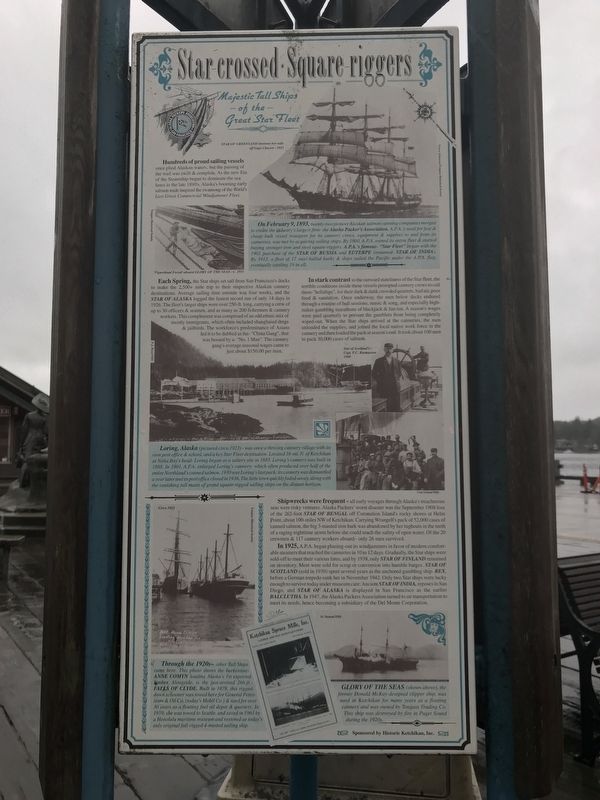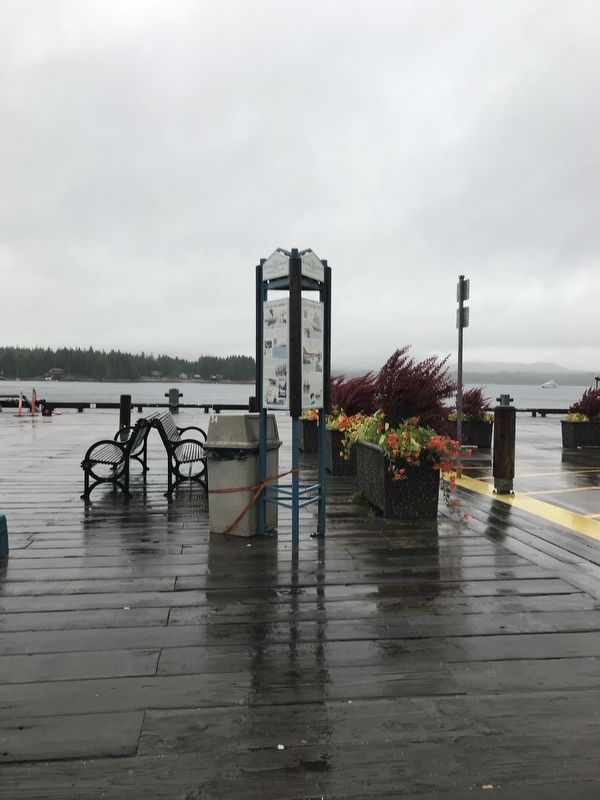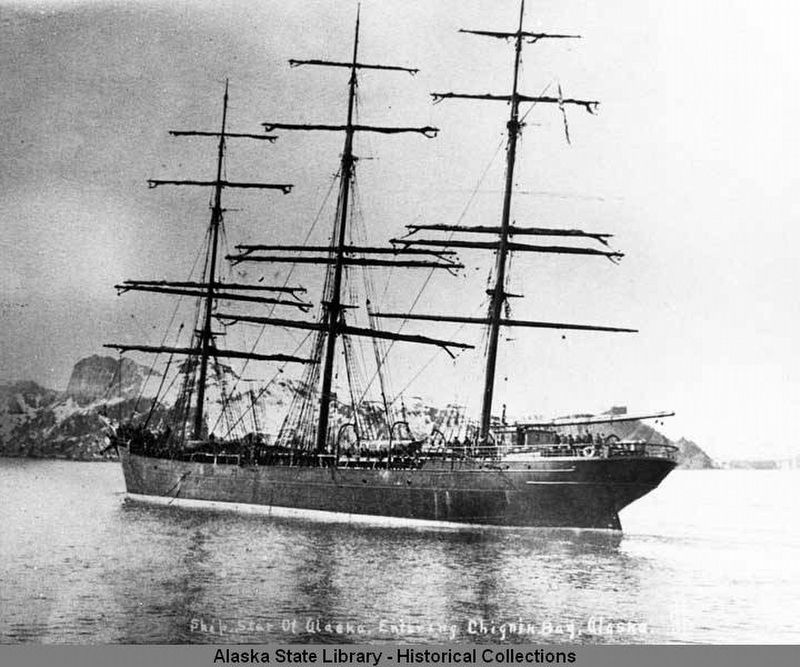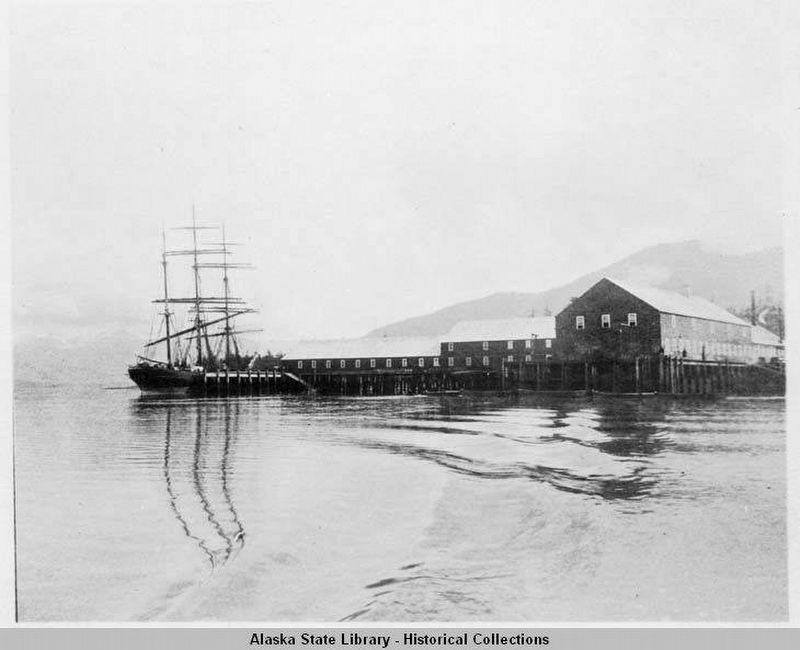Ketchikan in Ketchikan Gateway Borough, Alaska — Northwest (North America)
Star-crossed Square Riggers
Majestic Tall Ships of the Great Star Fleet
On February 9, 1893, twenty-two pioneer Alaskan salmon canning companies merged to create the industry's largest firm — the Alaska Packer's Association. A.P.A.'s need for fast & cheap bulk vessel transport for its cannery crews, equipment & supplies to and from its canneries, was met by acquiring sailing ships. By 1900, A.P.A. owned its entire fleet & started buying stronger iron and steel square-riggers. A.P.A.'s famous “Star Fleet” began with the 1901 purchase of the Star of Russia and Euterpe (renamed Star of India). By 1913, a fleet of 17 steel-hulled barks & ships sailed the Pacific under the A.PA. flag, eventually totaling 19 in all.
Each Spring, the Star ships set sail from San Francisco's docks to make the 2.500+ mile trip to their respective Alaskan cannery destinations. Average sailing time enroute was four weeks, and the Star of Alaska logged the fastest record run of only 14 days in 1926. The fleet's larger ships were over 250 ft. long, carrying a crew of up to 30 officers & seamen, and as many as 200 fishermen & cannery workers. This complement was comprised of an odd ethnic mix of mostly immigrants, which often included shanghaied dregs & jailbirds. The workforce's predominance of Asians led it to be dubbed as the “China Gang” that was bossed by a “No. 1 Man”. The cannery gang's average seasonal wages came to just about $150.00 per man.
In stark contrast to the outward stateliness of the Star fleet, the terrible conditions inside these vessels prompted cannery crews to call them “hellships” for their dark & dank crowded quarters, bad air, poor food & sanitation. Once underway, the men below decks endured through a routine of bull sessions, music & song, and especially high-stakes gambling marathons of blackjack & fan-tan. A season's wages were paid quarterly to prevent the gamblers from being completely wiped-out. When the Star ships arrived at the canneries, the men unloaded the supplies, and joined the local native work force in the cannery and then loaded the pack at season's end. It took about 100 men to pack 30,000 cases of salmon.
Shipwrecks were frequent — all early voyages through Alaska's treacherous seas were risky ventures. Alaska Packers' worst disaster was the September 1908 loss of the 262-foot Star of Bengal off Coronation Island's rocky shores at Helm Point, about 100 miles NW of Ketchikan. Carrying Wrangell's pack of 52,000 cases of canned salmon, the big 3-masted iron bark was abandoned by her tugboats in the teeth of a raging nighttime storm before she could reach the safety of open water. Of the 20 crewmen & 117 cannery workers aboard, only 26 men survived.
In 1925, A.P.A. began phasing out its windjammers in favor of modern comfortable steamers that reached the canneries in 10 to 12 days. Gradually, the Star ships were sold off to meet their various fates, and by 1938, only Star of Finland remained on inventory. Most were sold for scrap or conversion into humble barges. Star of Scotland (sold in 1930) spent several years as the anchored gambling ship Rex before a German torpedo sunk her in November 1942. Only two Star ships were lucky enough to survive today under museum care: Ancient Star of India reposes in San Diego, and Star of Alaska is displayed in San Francisco as the earlier Balclutha. In 1947, the Alaska Packers Association turned to air transportation to meet its needs, hence becoming a subsidiary of the Del Monte Corporation.
Captions
(Top, left) 'Figurehead Facial' aboard Glory of the Seas c. 1915 Tongass Historical Society
(Top, right) Star of Greenland shortens her sails off Cape Chacom 1923 Sixten
Johanson/Tongass Historical Society
(Center, left) Loring, Alaska (pictured circa 1923) was once a thriving cannery village with its own post office & school, and a key Star Fleet destination. Located 16 mi. N. of Ketchikan at Naha Bay's head, Loring began as a saltery site in 1883. Loring's cannery was built in 1888. In 1901, A.P.A. enlarged Loring's cannery, which often produced over half of the entire Northland's canned salmon. 1930 was Loring's last pack; its cannery was dismantled a year later and its post office closed in 1936. The little town quickly faded away, along with the vanishing tall masts of grand square-rigged sailing ships on the distant horizon. F.J. Hunt/THS
(Center, right) Star of Scotland's Capt. P.C. Rasmussen 1909 Cam Giebl/THS
(Bottom, left) Through the 1920s other Tall Ships came here. This photo shows the barkentine Anne Comyn loading Alaska's 1st exported lumber. Alongside is the just-arrived 266-ft. Falls of Clyde. Built in 1878, this rigged-down schooner was towed here for General Petroleum & Oil Co. (today's Mobil Co.) & used for over 30 years as a floating fuel oil depot & quarters. In 1959, she was towed to Seattle and saved in 1963 by a Honolulu maritime museum and restored as today's only original full-rigged 4-masted sailing
ship. Circa 1922 — Tongass Historical Society
(Bottom, right) Glory of the Seas (shown above), the former Donald McKay-designed clipper ship, was used in Ketchikan for many years as a floating cannery and was owned by Tongass Trading Co. This ship was destroyed by fire in Puget Sound during the 1920s. D. Nichols/THS
Erected by Historic Ketchikan, Inc.
Topics. This historical marker is listed in these topic lists: Industry & Commerce • Waterways & Vessels. A significant historical date for this entry is February 9, 1893.
Location. 55° 20.475′ N, 131° 38.83′ W. Marker is in Ketchikan, Alaska, in Ketchikan Gateway Borough. Marker is at the intersection of Front Street and Mission Street, on the right when traveling south on Front Street. Touch for map. Marker is at or near this postal address: 131 Front Street, Ketchikan AK 99901, United States of America. Touch for directions.
Other nearby markers. At least 8 other markers are within walking distance of this marker. Proud Canoes & Coastal Traders (here, next to this marker); When 'Steam was Queen' (here, next to this marker); Ketchikan Waterfront from Pennock Island, 1905 (within shouting distance of this marker); Tongass Trading Company (within shouting distance of this marker); Trials by Fire (within shouting distance of this marker); South Front Street (within shouting distance of this marker); Spirit & Sparks (within shouting distance of this marker); The Gilmore Hotel (about 400 feet away, measured in a direct line). Touch for a list and map of all markers in Ketchikan.
Also see . . .
1. Wreck of the Star of Bengal. By Gig Decker in National Fisherman, posted July 3, 2020. (Submitted on September 16, 2021, by Duane and Tracy Marsteller of Murfreesboro, Tennessee.)
2. Sockeye and the Age of Sail: The story of the Alaska Packers Association (YouTube). More than gold, more than furs, salmon was the lure that led men north. And, at the turn of the Twentieth Century, the Alaska Packers Association dominated the Pacific salmon industry from San Francisco to Bristol Bay, beyond the Aleutian Chain. In the Alaska territory, where frontier capitalism was utterly unfettered, the salmon cartel used its size, its capital and its Great Star Fleet to subdue the competition. Documentary by Southeast Seiners, uploaded April 22, 2011. (Submitted on September 16, 2021, by Duane and Tracy Marsteller of Murfreesboro, Tennessee.)
Credits. This page was last revised on September 16, 2021. It was originally submitted on September 15, 2021, by Duane and Tracy Marsteller of Murfreesboro, Tennessee. This page has been viewed 171 times since then and 33 times this year. Photos: 1, 2. submitted on September 15, 2021, by Duane and Tracy Marsteller of Murfreesboro, Tennessee. 3, 4. submitted on September 16, 2021, by Duane and Tracy Marsteller of Murfreesboro, Tennessee.



